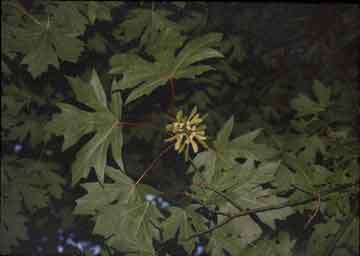
Standard English Name(s):
bigleaf or Oregon maple
Local English Name(s): maple
Scientific Name(s): Acer macrophyllum Pursh
Upriver Halkomelem Name(s):
Downriver Halkomelem Name(s):
Island Halkomelem Name(s): q'umun'ulhp
~ q'umul'ulhp ![]()
![]() Low
bandwidth video / High
bandwidth video
Low
bandwidth video / High
bandwidth video
Description, Habitat, Ecology, & Distribution:
This species has the largest leaves of
any maple, hence the common name (and the scientific specific epithet
macrophyllum, which means big leaf). It is a large, often multi-stemmed,
deciduous tree, which may reach a height of 35 m (115 ft). The greenish-yellow
flowers, which are borne in large, hanging clusters, mature to produce
winged fruits (samaras) that are disseminated by wind. This tree occurs
on dry to moist sites, at low to middle elevations from southwestern
British Columbia to southern California. It occurs throughout the Halkomelem
territory.
Upriver Halkomelem Cultural Role(s):
The wood was used for making canoe
paddles, dishes, and fish clubs.
Downriver Halkomelem Cultural Role(s):
Island Halkomelem Cultural Role(s):
Bigleaf maple wood has been used for paddles,
bowls, spoons, utensils, for carving and to smoke fish. The "sap" (cambium),
removed from the layer between the bark and the wood, is a traditional
food. The winged fruits, which fly through the air like a whirlybird,
were used as a lure for fishing lingcod (Ophiodon elongatus) and "red
snapper" (or yelloweye rockfish, Sebastes ruberrimus). The large leaves
were used as an undermat for drying some edible fruits and roots.